The Wachau Cultural Landscape is a valley located on the banks of the river Danube between the cities Melk and Krems an der Donau, 80 km upstream from Vienna. The Wachau Valley is one of the prominent tourist destinations of Austria. Impressive castles, ruins and monasteries are dominating the small picturesque villages in the Danube valley. Göttweig Abbey and Melk Abbey are renowned for their Baroque architecture, both the abbeys are located on an Austrian section of the Way of St. James, the Route of Santiago de Compostela. The ruins of the Aggstein Castle and the Dürnstein Castle offers magnificent views over the Danube and Wachau valley. Willendorf an der Donau is known as the town where the Venus of Willendorf was discovered, a fertility symbol, dating from the period 24.000-22.000 BC. Nowadays, the original statuette of the 'Venus of Willendorf' is housed in the Naturhistorisches Museum in Vienna. The Wachau Valley was already inhabited in prehistoric times. The Wachau Valley preserves many traces of agricultural use, mainly the cultivation of vines. The valley is famois for its wines, apricot jams and liqueur. The Wachau Cultural Landscape was declared a UNESCO World Heritage in 2000.
www.werelderfgoedfotos.nl © Copyright World Heritage Photos
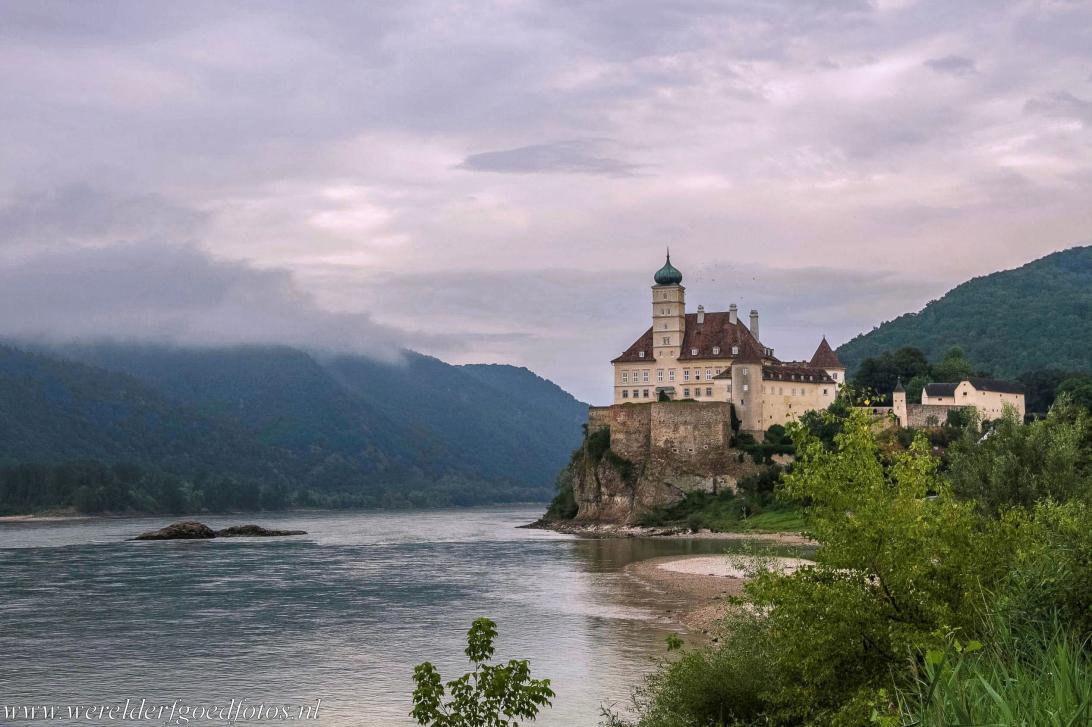
Wachau Cultural Landscape: Schloss Schönbühel, also known as the 'Watchman of the Wachau', stands on a rock on the banks of the River Danube and is overlooking the town of Schönbühel in the Wachau Valley. Schloss Schönbühel is located about five km from Melk. The Wachau Cultural Landscape is a valley located on the banks of the Danube. The Wachau Cultural Landscape was inscribed on the UNESCO World Heritage List in 2000.

Wachau Cultural Landscape: Schloss Schönbühel, also known as the 'Watchman of the Wachau', stands on a rock on the banks of the River Danube and is overlooking the town of Schönbühel in the Wachau Valley. Schloss Schönbühel is located about five km from Melk. The Wachau Cultural Landscape is a valley located on the banks of the Danube. The Wachau Cultural Landscape was inscribed on the UNESCO World Heritage List in 2000.
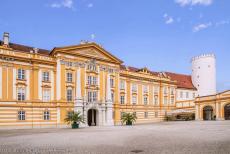
Wachau Cultural Landscape: The historic buildings of the Baroque Abbey of Melk are arranged around seven courtyards. The abbey stands on a rock, overlooking the Danube and the Wachau Valley. The Wachau Valley is a section of the Danube Valley. Impressive castles, monasteries and castle ruins are dominating the picturesque villages in the Wachau Valley. Most famous are the ancient monasteries of Melk and Göttweig.
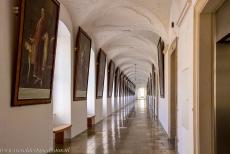
Wachau Cultural Landscape: The Kaisergang, the Emperor's Gallery, in the Abbey of Melk is also known as the Imperial Corridor. The gallery is almost 200 metres long and is decorated with the royal portraits of all the rulers of Austria, from the Babenbergs to the Habsburgers, the Imperial Corridor is situated in the Kaisertrakt, the Imperial Rooms. Benedictine monks have been living and working in the Abbey of Melk since 1088.
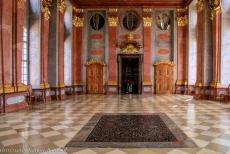
Wachau Cultural Landscape: The Marble Hall of the Abbey of Melk is a large ballroom and dining room. The Marble Hall has red marble columns and door frames, the walls are stucco marble. In the middle of the marble floor is a hot air heater. The ceiling fresco was created by the Austrian painter and draughtsman Paul Troger, the huge fresco depicts the Greek goddess Pallas Athena on a chariot drawn by lions, the Greek god Hercules is on her left side.
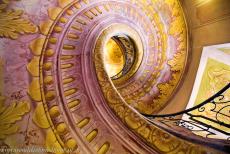
Wachau Cultural Landscape: The Baroque spiral staircase of the Melk Abbey is leading from the library down to the church. The spiral staircase looks like hundreds of metres deep, but it is only an optical illusion because mirrors were placed at the top and the bottom of the staircase. The library consists of twelve rooms, it houses about 100,000 manuscripts. Only the main hall of the library is open to visitors.
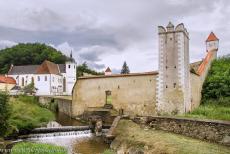
Wachau Cultural Landscape: The Carthusian monastery in the Austrian village of Aggsbach. The Carthusian monastery was founded in 1380. In 1782, the monastery was dissolved by Emperor Joseph II and converted into a castle. The Gothic church and additional tower of the monastery remained intact and used as the parish church of Aggsbach. Aggsbach is a small market town in the Wachau valley.
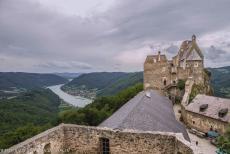
Wachau Cultural Landscape: Aggstein Castle was built in the 12th century, the ruins of the castle are situated on top of a rock, about 300 metres above the Wachau Valley, the most spectacular part of the Danube Valley in Austria. Numerous impressive castles, ruins and monasteries are dominating the Danube valley. The Wachau Cultural Landscape is situated between the villages of Melk and Krems an der Donau, about 80 km upstream from Vienna, the capital city of Austria.
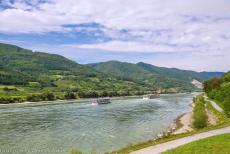
Wachau Cultural Landscape: The hamlet of Willendorf is located on the banks of the Danube, it is known as the place were the Venus of Willendorf was found, 45.000-23.000 years ago already people lived in the area around Willendorf. The remains of those hunter-gatherers were found in 1908 during the construction of a railway. The most important discovery was a statuette, the 'Venus of Willendorf', it is 11.1 cm high and was made between 24.000-22.000 BCE.
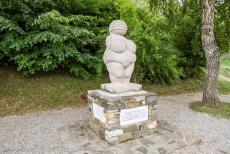
Wachau Cultural Landscape: A replica version of the 'Venus of Willendorf', located in the hamlet of Willendorf, on the site where the original 'Venus of Willendorf' was discovered. The original statuette of the 'Venus of Willendorf', dating from 24.000-22.000 BC, is nowadays located in the Naturhistorisches Museum in Vienna, Austria. In the hamlet of Willendorf is a small museum, it shows an exact replica of the statuette and several tools and fossils dating from the Stone Age.
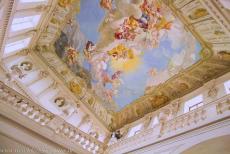
Wachau Cultural Landscape: The fresco above the Imperial Staircase of Göttweig Abbey. One of the highlights of the abbey is the Imperial Staircase, the Kaiserstiege. The three storied Imperial Staircase was built in 1738. The colourful ceiling fresco was created by the Austrian painter and draughtsman Paul Troger in 1739. The Imperial Staircase of the Göttweig Abbey is considered a masterpiece of the Baroque architecture in Austria.
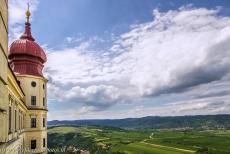
Wachau Cultural Landscape: Göttweig Abbey overlooking the Wachau Landscape in the Danube Valley. Göttweig Abbey is located near the town of Krems in Lower Austria. Göttweig Abbey was founded in 1083 as a community of Augustinian canons and it became a Benedictine monastery in 1094. Göttweig Abbey was damaged by fire several times. After a fire in 1718, the abbey was restored in the Baroque style, the design was influenced by El Escorial in Spain. Göttweig Abbey is located on an Austrian section of the Way of St. James, the Route of Santiago de Compostela.
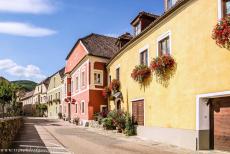
Wachau Cultural Landscape: The tiny picturesque village of Weißenkirchen in the Wachau Valley. Weißenkirchen is surrounded by vineyards and apricot trees. The Wachau Valley is known for its wines, apricot jam and apricot liqueur. The valley is one of the prominent tourist destinations in Austria. The Wachau Cultural Landscape was declared a UNESCO World Heritage in 2000.
